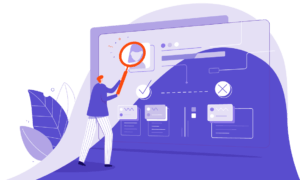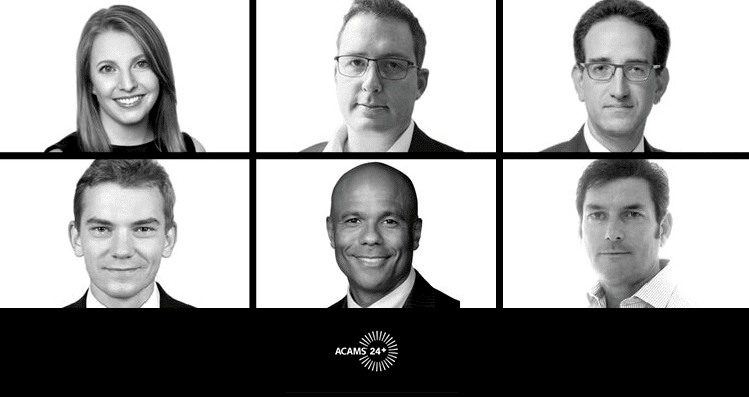As a leading Anti–Money Laundering solution in the Intelligent Automation space, WorkFusion was proud to sponsor the recent ACAMS24+ Global Virtual Summit where speakers and attendees discussed financial crime and how people around the world are determined to mitigate and prevent it. The ACAMS conference featured conversations centered around hard-hitting topics such as emerging technology trends, adapting financial crime prevention to a crisis environment, and the evolution of a regulatory landscape in a digitized future.

Kirill Meleshevich, WorkFusion’s Global Head of AML, participated in a panel session, “FinTech in Context: What It Means to AML — and What It Will” along with Melissa Strait of Stripe, Greg Ruppert of FINRA, and Howard Fields of Mastercard.

Their lively discussion included opportunities and risks of fintech in the ongoing disruption of how banking services are provided, and how AML compliance is managed. Kirill noted there were many factors driving challenger banks and traditional financial institutions to operate in newer, better ways — even before the recent economic shakeup, and that the COVID-19 crisis only amplifies this need. He emphasized the importance of labeling digitization as an organizational mindset, not just a single project, task or technology.
(This was just one of many great sessions during ACAMS24+! Unfortunately, we can only cover a few hot topics in this article. We recommend watching the website to know when all sessions are available on-demand so you can access the full 24 hours of content!)
These industry conversations, as well as discussions with WorkFusion customers, enable us to observe how top companies will define a new normal and excel in a post-COVID world.
Our key takeaways from the ACAMS conference and recent customer feedback include:
- Strategic cost reduction continues to be a prominent business consideration
- Digital acceleration has affected both fraudsters and AML experts
- Regulatory and government expectations for compliance remain high
- Companies bold enough to establish a new digital behavior have excelled
View from high above – looking at the pandemic big picture
Even though not as many people are flying these days, let’s try to take a 30,000-foot, sky-high view of the current business environment to understand common themes and ideas from customers and experts alike. Companies continue to operate in a predominantly remote environment, and the pace of hiring has remained slow across most industries. However, we are seeing projects pick back up while budget allocation and IT stacks are being reprioritized. C-level leaders are framing (or re-framing) their digital agendas, and as they seek to “bring the work back” post-COVID, these leaders are focused, more than ever, on how to strategically cut costs within their enterprises.
For WorkFusion customers, as well as other enterprises represented at this ACAMS conference, governance, risk and compliance functions stand out as the most prominent cost centers globally and represent key areas where companies are attempting to improve their bottom lines. They are recognizing a shining light, in the form of artificial intelligence (AI), which can bring operational efficiencies to their enterprises.
Old problems are appearing in new guises
A shift into the digital age, expedited by requirements of the pandemic, means both the fraudsters and the folks combatting this activity are adapting quickly. As government aid floods into our global economic system, bad actors are tweaking old-time scams to exploit current economic chaos and stimulus spending. Companies need to understand risk and mitigate it across their organizations, with agility. Many top financial institutions are deploying analytical software and other technology to mine data based on a particular typology or trend — such as investigating matters like secondary transfers of stimulus funds, significant increases in charitable contributions, medical fraud, and spikes in wealth management activity.
During one ACAMS24+ session, “The Investigator-Centered Approach to Financial Crime: Doing What Matters,” Kate Robu and Olivia Conjeaud of McKinsey and Co. astutely point out that companies need to shift focus from minimizing the amount of potentially suspicious activity (in the form of alerts) toward handling the actual criminal activity. They suggest reducing “noise” from transactional or sanction alerts with machine learning-based detection models, while leveraging the same technology to prioritize the alerts that are meaningful.
Regulators insist enterprises must prove they understand risk
Regulators have shown sensitivity towards financial institutions given COVID-19 constraints, but expectations persist that financial institutions must continue to deliver on regulatory requirements. Many WorkFusion customers are assessing their ability to map global regulatory requirements to their current constraints.

Banks cannot take their eyes off AML compliance. In the past, regulatory scrutiny was heightened for AML compliance in the aftermath of a financial crisis, and we expect that trend to continue. As financial institutions continue to leverage automation to tackle complex compliance requirements, it is important that they obtain regulator buy-in as they go.
Many of our customers are having conversations early on with examiners, covering what they are planning, how they are going to manage their model risks, and discussing re-training cadences. Allowing regulators to “ride along” on the AML automation journey has been a key factor in digital transformation program success.
Top companies boldly defining new behavior for automation
It’s been very interesting for us at WorkFusion to see how automation technology like ours has been used during the coronavirus crisis as a new lever that institutions implement to work their way through the current environment. We have seen financial institutions, with significant impact on their offshore operations teams, successfully utilize automation to onboard customers, conduct compliance checks, and process payments without delay.
We’ve also seen many of our customers leverage automation horizontally across multiple functional processes, to build a better business case and increase ROI. For example: During the onboarding of customers, almost every financial institution will do some form of adverse monitoring. What we typically see is that this use case applies horizontally across an organization not only for onboarding but is applicable for AML automation in terms of ongoing KYC compliance, fraud and credit. This overlap is an extremely important factor that many companies do not take the time to properly understand upfront. Discovering high-value use cases and finding ways to reuse models to realize economies of scale is key to successfully building a robust automation journey.
We’ve found that leaders who have set a new standard of digital behavior within their organizations have been able to more effectively deal with the uncertainties and volatilities of this current environment while establishing a foundational path for future growth and stability.
Questions about AML automation? Please feel free to reach out anytime — we’re always happy to learn more about your interests and needs.





























